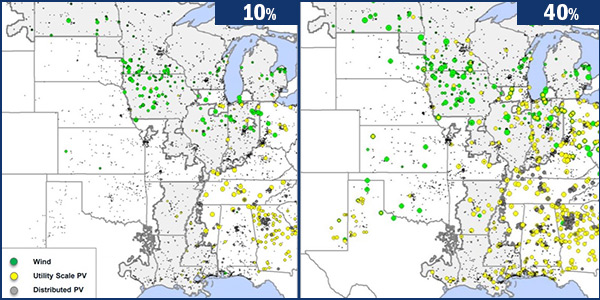By Amanda Durish Cook
MISO will need to take significant steps to reinforce its grid to handle 40% renewable penetration, according to RTO findings released last week.
At that share of renewables in its generation mix, MISO will experience a sharp increase in grid complexity in terms of resource adequacy, steady state operating reliability and hourly energy adequacy. The changes will require the RTO to roll out mitigating measures that could include buildout of new transmission, the study found.
“Interim results indicate integration complexity increasing sharply from 30% to 40% renewable penetration,” Policy Studies Manager Jordan Bakke said.
The findings are the latest in MISO’s yearslong renewable integration impact assessments, which seek to determine what volume of renewables it can incorporate into its footprint before the integration becomes “significantly” complex. The RTO is in phase two of the three-phase study.
In spring, MISO published study results showing that increased renewable integration, especially solar generation, will shift peak load to evening hours, with a spikier but shorter daily loss-of-load risk. (See MISO Renewable Study Predicts Later Peak, Narrower LOLE Risk.)
MISO last month said it could reliably absorb a 20% renewable penetration without undercutting frequency response. (See MISO: 20% Renewable Limit for Adequate Frequency Response.)
“We’re seeing that as renewable penetration increases, so do the operational complexities,” Bakke said.
The RTO now says that the variability swings resulting from 40% renewables could increase curtailment of renewables to about 18.2% of intervals. Bakke said various mitigating measures could halve curtailments.
MISO also said that, under current conditions, an overall capacity mix consisting of 40% renewable resources will translate into actual renewable penetration of just 34.7%, which could increase to 38.5% if the RTO introduces additional measures, including new transmission. Renewables at 40% could serve 41.7% of near-peak load, 67% of light load and 81.3% of load during peak conditions for renewables.
After studying about 11,300 new transmission project candidates, Bakke said MISO identified about 80 that would be cost-effective and allow it to “utilize the diverse variable resources.”
Veriquest’s David Harlan said MISO’s study did not demonstrate how capacity from gas and coal generation could help facilitate renewable expansion. He said the RTO may want to consider whether its markets are providing the right price incentives so coal and gas generation stay in the market.
But Bakke said the increasing variability resulting from a 40% renewable penetration can be addressed by ramping from its online conventional generators.
Bakke said MISO’s study shows the footprint will continue to need conventional generation. He said even though average ramping needs change slightly at a 40% renewable mix, the remaining conventional generators will have more pronounced requirements, needing to provide greater volumes of up and down ramping.
As MISO nears a mix with 50% renewables, he said, it will experience more renewable energy available than needed for load at certain times of the year, resulting in a “net negative” load.
MISO will hold a workshop on the assessment Nov. 28, where stakeholders will discuss the preliminary impacts of increasing levels of renewable penetration in more detail.





